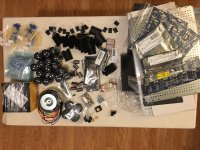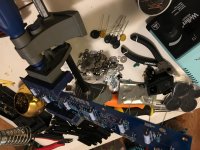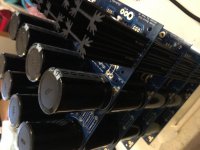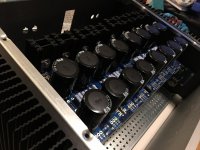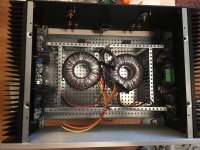I wasn't able to attend Burning Amp 2016, but I am definitely looking forward to Ampsgiving! This year the festival lasts TEN DAYS while the family is out of town. They're visiting relatives for another U.S. holiday at the end of November, and I'll be soldering.
For me, this year's celebration centers on a pair of Magnepan 2.7QR speakers I recently acquired. I love these things, and want to feed them the best quality watts I can muster.
Traditionally for Ampsgiving you start one project, finish one project and help someone else with a project.
So in the DIY spirit of overkill, naturally I have several projects to start, and want to finish them all, not just one. And I'll be helping a coworker learn to solder, and perhaps give away a soldering iron and/or some LEDs or resistors or whatnot. (Isn't that what Ampsgiving is really all about, anyway? Maybe it's become too comercial.)
I've been powering my Magnepans with a Winsome Labs Mouse which I built from a kit. It puts 45 watts into 4 ohms and sounds surprisingly good. But I want better! So, here's what's on the menu this year—
Full dual mono Aikido preamp with adjustable impedance Tortuga LDR attenuator & remote
I'm calling this a full dual mono because it's got a pair of 9-pin mono Aikido line amp boards from John Broskie, each powered by a separate power supply board (PS-1, also from Broskie). Each power board provides separate high and low voltage DC supplies for B+ and heaters, fed by separate high and low voltage toroidal.
The Tortuga LDR modules provide remote control, attenuation, source switching and the front panel LED displays, and are fed by a separate 12V power supply (LV-1, also from Broskie) and 25VA transformer. Power to the Aikido boards is controlled by a 12V trigger (there is no external power switch). Also, that's five donuts.
This preamp will run four 6CG7 tubes, configured for around 20 dB in gain. I bought an aluminum chassis with predrilled holes off eBay. There's not a whole lot of room inside the case, and the boards have been positioned to keep heatsinks and tubes directly beneath the vents in the cover. I may have to vent the bottom as well. Because the vents run along the left- and right-hand sides of the cover, one channel's Aikido and power supply boards will be stuffed and mounted upside-down to maintain symmetry and keep the tubes and heatsinks positioned under the vents. I may regret this when it comes to troubleshooting.
The case came with two knobs, and I only need one to operate the encoder input to the Tortuga board. The other knob, I may just attach another encoder and let them both do the same thing. I've also thought about putting an output capacitor selector there, but that would involve running signal from the back of the unit up to the front and then back to the back panel. All the signal input, manipulation and output is currently done at the back of the unit, and all the donuts, power supplies and controls are at the front.
Pair of Nelson Pass F4 "Wild Weasel" edition full dual monoblocks
Also known as the "so you want current?" edition. The name "Wild Weasel" is a reference to the electronic warfare missions my dad flew in F4 Phantom jets when I was a pup. I'm calling these full dual mono since each monoblock has two separate power supplies, each fed via 250VA donut and carrying 4 x 22,000uF in capacitors per donut. These will live inside a pair of diyAudio 4U "jack of all chassis” cases.
The hope is that the Aikido preamp plus running each F4 in parallel mode will give my Magnepan speakers the voltage gain and current they crave.
The preamp case has two sets of output jacks. (Most likely this case was for an integrated amp and the outputs are supposed to be binding posts.) And the Aikido boards have two separate output capacitors each, suitable for driving separate outputs or selectable tone. So I am going to experiment with putting different capacitors on each output, and then running those outputs into each monoblock.
It won't be exactly parallel, each half of the F4 would see a slightly different signal instead of just jumpering the inputs. But the outputs will still be tied together. How will it sound? I have no idea! Will it blow up my F4? I sure hope not! I'm betting it won't!
I have no idea if I can get this much done in ten days. I think I've finally collected all the parts, so I'm hopeful.
For me, this year's celebration centers on a pair of Magnepan 2.7QR speakers I recently acquired. I love these things, and want to feed them the best quality watts I can muster.
Traditionally for Ampsgiving you start one project, finish one project and help someone else with a project.
So in the DIY spirit of overkill, naturally I have several projects to start, and want to finish them all, not just one. And I'll be helping a coworker learn to solder, and perhaps give away a soldering iron and/or some LEDs or resistors or whatnot. (Isn't that what Ampsgiving is really all about, anyway? Maybe it's become too comercial.)
I've been powering my Magnepans with a Winsome Labs Mouse which I built from a kit. It puts 45 watts into 4 ohms and sounds surprisingly good. But I want better! So, here's what's on the menu this year—
Full dual mono Aikido preamp with adjustable impedance Tortuga LDR attenuator & remote
I'm calling this a full dual mono because it's got a pair of 9-pin mono Aikido line amp boards from John Broskie, each powered by a separate power supply board (PS-1, also from Broskie). Each power board provides separate high and low voltage DC supplies for B+ and heaters, fed by separate high and low voltage toroidal.
The Tortuga LDR modules provide remote control, attenuation, source switching and the front panel LED displays, and are fed by a separate 12V power supply (LV-1, also from Broskie) and 25VA transformer. Power to the Aikido boards is controlled by a 12V trigger (there is no external power switch). Also, that's five donuts.
This preamp will run four 6CG7 tubes, configured for around 20 dB in gain. I bought an aluminum chassis with predrilled holes off eBay. There's not a whole lot of room inside the case, and the boards have been positioned to keep heatsinks and tubes directly beneath the vents in the cover. I may have to vent the bottom as well. Because the vents run along the left- and right-hand sides of the cover, one channel's Aikido and power supply boards will be stuffed and mounted upside-down to maintain symmetry and keep the tubes and heatsinks positioned under the vents. I may regret this when it comes to troubleshooting.
The case came with two knobs, and I only need one to operate the encoder input to the Tortuga board. The other knob, I may just attach another encoder and let them both do the same thing. I've also thought about putting an output capacitor selector there, but that would involve running signal from the back of the unit up to the front and then back to the back panel. All the signal input, manipulation and output is currently done at the back of the unit, and all the donuts, power supplies and controls are at the front.
Pair of Nelson Pass F4 "Wild Weasel" edition full dual monoblocks
Also known as the "so you want current?" edition. The name "Wild Weasel" is a reference to the electronic warfare missions my dad flew in F4 Phantom jets when I was a pup. I'm calling these full dual mono since each monoblock has two separate power supplies, each fed via 250VA donut and carrying 4 x 22,000uF in capacitors per donut. These will live inside a pair of diyAudio 4U "jack of all chassis” cases.
The hope is that the Aikido preamp plus running each F4 in parallel mode will give my Magnepan speakers the voltage gain and current they crave.
The preamp case has two sets of output jacks. (Most likely this case was for an integrated amp and the outputs are supposed to be binding posts.) And the Aikido boards have two separate output capacitors each, suitable for driving separate outputs or selectable tone. So I am going to experiment with putting different capacitors on each output, and then running those outputs into each monoblock.
It won't be exactly parallel, each half of the F4 would see a slightly different signal instead of just jumpering the inputs. But the outputs will still be tied together. How will it sound? I have no idea! Will it blow up my F4? I sure hope not! I'm betting it won't!
I have no idea if I can get this much done in ten days. I think I've finally collected all the parts, so I'm hopeful.
First day of Ampsgiving: Remember what you have. (Listen to your system so you remember how it used to sound.)
First, Pioneer CS-R300, purchased new by my grandfather, powered over the years via various things like Realistic stereos, Sony and Denon receivers, etc.
The story so far: Replace speakers with Dennis Murphy's Philharmonitors. "I had no idea my receiver could do that!"
Replace amp with Winsome Labs Mouse I built from a kit. "I had no idea my speakers could do that!"
Switch to Magnepan 2.7qr speakers: "I had no idea that Mouse could do that!"
First, Pioneer CS-R300, purchased new by my grandfather, powered over the years via various things like Realistic stereos, Sony and Denon receivers, etc.
The story so far: Replace speakers with Dennis Murphy's Philharmonitors. "I had no idea my receiver could do that!"
Replace amp with Winsome Labs Mouse I built from a kit. "I had no idea my speakers could do that!"
Switch to Magnepan 2.7qr speakers: "I had no idea that Mouse could do that!"
So the project I'm completing for Ampsgiving this year is going to be the F4s. I'd like the preamp to be one of this year's projects but it's been in the running several years now, and I'm not holding out hope. That thing katamari's feature like nobody's business.
I have selected the project I'm starting this year: a pair of Sigfried Linkwitz's LXmini, driven by four of Neurochrome's ridiculously low distortion amps.
I have selected the project I'm starting this year: a pair of Sigfried Linkwitz's LXmini, driven by four of Neurochrome's ridiculously low distortion amps.
It's an F4! Well, the pieces for one, anyway. I miscounted the capacitors in my post above. I think this amp is like 85 percent power supply at this point.
This one is going to be the Wild side. The Weasel side will be the same except the transformers are Avel Lindberg instead of Triad.
This one is going to be the Wild side. The Weasel side will be the same except the transformers are Avel Lindberg instead of Triad.
Attachments
I ran out of parts, I have yet to apply current to a single circuit, but Ampsgiving 2016 has been a complete blast. I ended up swiping parts from the Neurochrome amps, so now I've got two projects to resupply. And really, that's got to be at least half the fun, since it appears to be where I end up spending 90 percent of my time...
If you only put two per chassis it fits better, so no tower of power. The eagle eyed will notice the back panel has some issues regarding orientation. There are good reasons I've decided to go with unscrewable everything rather than soldering connecting wires. I've got to be able to go back in there and fix all the terrible mistakes I'll probably make.
Attachments
The power cage! This mostly supports the power supply boards, but the little risers from the diyaudio store remind me of erector sets, and are as much fun to play with, I couldn't resist adding a couple non-load-bearing pieces for, um, improved "shielding." So now I need to order more for the Weasel side. (I am still building two of these, I swear.)
Attachments
The preamp has gained a significant feature, and may end up losing its status as provider of delicious tubey Aikido voltage gain. I'm adding an ADC so I can digitize vinyl, and to make it easier to drive the digital crossover to run active speakers, the LXminis. I am considering just putting a tube output buffer in there and moving the Aikido gain to... dedicated external tube input stages for the F4's. And when you think about it, doubling the mumber of tubes and separate boxes is really the point here.
Now, for best results, put a pair of mono R2R ladder DACs in each of those dedicated Aikido voltage gain boxes. Now it's a digital input stage too.
So, with careful planning and a gleeful willingness to separate functionality into separate components, it really is possible to have that Ampsgiving feeling all year round. And that's what it's really all about.
Now, for best results, put a pair of mono R2R ladder DACs in each of those dedicated Aikido voltage gain boxes. Now it's a digital input stage too.
So, with careful planning and a gleeful willingness to separate functionality into separate components, it really is possible to have that Ampsgiving feeling all year round. And that's what it's really all about.
Also, while you CAN cram a set of mono Aikido boards and associated power supply boards and their associated four additional toroids into a diystore 4U chassis in addition to a dual mono F4... it doesn't mean you should.
Last edited:
I've been thinking about attenuation in an active system, and the easiest thing to do is attenuate the signal on the way into the digital crossover. But a better way would be to run the hottest signal you can into the ADC, then attenuate at the DAC out for each driver, right before its amplifier.
Some day I want to play with controlling gain by manipulating negative feedback instead of attenuating the input and leaving the gain itself alone.
Instead I'm toying with driving a 1khz sine wave through the analog portion of the preamp, while a fully hot digital signal gets sent to the DSP. The sine wave is attenuated by the normal Tortuga LDR circuit, but at the dedicated digital input/Aikido box it gets rectified into a DC voltage between 0-3.3v. That's then fed to the potentiometer input for each DAC to set its digital volume control.
Some day I want to play with controlling gain by manipulating negative feedback instead of attenuating the input and leaving the gain itself alone.
Instead I'm toying with driving a 1khz sine wave through the analog portion of the preamp, while a fully hot digital signal gets sent to the DSP. The sine wave is attenuated by the normal Tortuga LDR circuit, but at the dedicated digital input/Aikido box it gets rectified into a DC voltage between 0-3.3v. That's then fed to the potentiometer input for each DAC to set its digital volume control.
"If you hear a 1 kHz tone you are listening to the analog volume control signal. Turn the input switch from Analog to Digital..."
As Ampsgiving gives way to Ampsmas as it always must, one's thoughts turn inevitably toward, "What I need is a simple project I can finish while I wait for the parts for the preamp." For me, this project is the class A tube headphone amp, which I turn to whenever I hit a stopping point with another project. Intended from the start to be a quick project, it has taught me much about humility and just how much I have yet to learn.
After several disappointing chassis designs which would have looked gorgeous but could have served as a place to prepare various high temperature egg dishes, I finally decided to order a chassis from China and see what happens. Because I'm tired of messing with it, I want to listen to it!
After several disappointing chassis designs which would have looked gorgeous but could have served as a place to prepare various high temperature egg dishes, I finally decided to order a chassis from China and see what happens. Because I'm tired of messing with it, I want to listen to it!
I wasn't able to attend Burning Amp 2016, but I am definitely looking forward to Ampsgiving! This year the festival lasts TEN DAYS while the family is out of town. They're visiting relatives for another U.S. holiday at the end of November, and I'll be soldering.
For me, this year's celebration centers on a pair of Magnepan 2.7QR speakers I recently acquired. I love these things, and want to feed them the best quality watts I can muster.
Traditionally for Ampsgiving you start one project, finish one project and help someone else with a project.
So in the DIY spirit of overkill, naturally I have several projects to start, and want to finish them all, not just one. And I'll be helping a coworker learn to solder, and perhaps give away a soldering iron and/or some LEDs or resistors or whatnot. (Isn't that what Ampsgiving is really all about, anyway? Maybe it's become too comercial.)
I've been powering my Magnepans with a Winsome Labs Mouse which I built from a kit. It puts 45 watts into 4 ohms and sounds surprisingly good. But I want better! So, here's what's on the menu this year—
Full dual mono Aikido preamp with adjustable impedance Tortuga LDR attenuator & remote
I'm calling this a full dual mono because it's got a pair of 9-pin mono Aikido line amp boards from John Broskie, each powered by a separate power supply board (PS-1, also from Broskie). Each power board provides separate high and low voltage DC supplies for B+ and heaters, fed by separate high and low voltage toroidal.
The Tortuga LDR modules provide remote control, attenuation, source switching and the front panel LED displays, and are fed by a separate 12V power supply (LV-1, also from Broskie) and 25VA transformer. Power to the Aikido boards is controlled by a 12V trigger (there is no external power switch). Also, that's five donuts.
This preamp will run four 6CG7 tubes, configured for around 20 dB in gain. I bought an aluminum chassis with predrilled holes off eBay. There's not a whole lot of room inside the case, and the boards have been positioned to keep heatsinks and tubes directly beneath the vents in the cover. I may have to vent the bottom as well. Because the vents run along the left- and right-hand sides of the cover, one channel's Aikido and power supply boards will be stuffed and mounted upside-down to maintain symmetry and keep the tubes and heatsinks positioned under the vents. I may regret this when it comes to troubleshooting.
The case came with two knobs, and I only need one to operate the encoder input to the Tortuga board. The other knob, I may just attach another encoder and let them both do the same thing. I've also thought about putting an output capacitor selector there, but that would involve running signal from the back of the unit up to the front and then back to the back panel. All the signal input, manipulation and output is currently done at the back of the unit, and all the donuts, power supplies and controls are at the front.
Pair of Nelson Pass F4 "Wild Weasel" edition full dual monoblocks
Also known as the "so you want current?" edition. The name "Wild Weasel" is a reference to the electronic warfare missions my dad flew in F4 Phantom jets when I was a pup. I'm calling these full dual mono since each monoblock has two separate power supplies, each fed via 250VA donut and carrying 4 x 22,000uF in capacitors per donut. These will live inside a pair of diyAudio 4U "jack of all chassis” cases.
The hope is that the Aikido preamp plus running each F4 in parallel mode will give my Magnepan speakers the voltage gain and current they crave.
The preamp case has two sets of output jacks. (Most likely this case was for an integrated amp and the outputs are supposed to be binding posts.) And the Aikido boards have two separate output capacitors each, suitable for driving separate outputs or selectable tone. So I am going to experiment with putting different capacitors on each output, and then running those outputs into each monoblock.
It won't be exactly parallel, each half of the F4 would see a slightly different signal instead of just jumpering the inputs. But the outputs will still be tied together. How will it sound? I have no idea! Will it blow up my F4? I sure hope not! I'm betting it won't!
I have no idea if I can get this much done in ten days. I think I've finally collected all the parts, so I'm hopeful.
I see from your yesterday post that the F4s aren't finished yet ... I hope you are able to get them done soon. 🙂
But IMO, they won't make your 2.7s sound as magnificent as they could be. Reading the F4 specs, they are:
* 50w into 4 ohms, and reading from the F4 blurb
* "suitable for driving a high sensitivity loudspeaker with the output voltage of a preamp or other line-level audio source. It is also useful with a less sensitive loudspeaker in a bi-amped configuration where it takes input from the output of a conventional amplifier."
MG-2.7s are not 'high sensitivity' ... and I don't think you are biamping? 😕
I appreciate your ethos is to build amps, not buy them but I would suggest, to get your 2.7s singing their best you need to do one of 2 things:
1. Build an amp which has a great deal more power than the F4s - and yes, I do understand that the F4s deliver lotsa current! 😀
2. Or at least, actively bi-amp your 2.7s. I don't think the F4s will be the best amps for the bass panels but they will do a great job on the mids & tweeters. 🙂 For the bass panels ... maybe build up some Hypex D-class monoblocs of at least 300w into 4 ohms?
Andy
The preamp has gained a significant feature, and may end up losing its status as provider of delicious tubey Aikido voltage gain. I'm adding an ADC so I can digitize vinyl, and to make it easier to drive the digital crossover to run active speakers, the LXminis. I am considering just putting a tube output buffer in there and moving the Aikido gain to... dedicated external tube input stages for the F4's. And when you think about it, doubling the mumber of tubes and separate boxes is really the point here.
Now, for best results, put a pair of mono R2R ladder DACs in each of those dedicated Aikido voltage gain boxes. Now it's a digital input stage too.
So, with careful planning and a gleeful willingness to separate functionality into separate components, it really is possible to have that Ampsgiving feeling all year round. And that's what it's really all about.
Very interesting, BBD! I have started along a similar path! 😀
I have been running 3-way active Maggies for about 15 years; I recently made them 4-way by adding a pair of 15" subs. As part of this move, I replaced my 3-way analogue active XOs with a miniDSP 10x10Hd unit.
Currently, I have 4 sources going into my (analogue) preamp ... the (single) output from this feeds the 10x10Hd's analogue input - and 8x analogue outputs feed the amp channels.
I have started a project to change my setup to:
* ADC after my phono stage.
* this is 1 input into a 4-way digital source selector.
* the other 3 digital inputs are: CDP, DAB+ tuner and TV set-top box.
* the selected output from the digital source selector feeds the digital input of the miniDSP unit.
* the 8 analogue outputs of the miniDSP unit then go into a component which has:
- an 8-channel, digitally-controlled analogue volume control (as the preamp's overall volume controller has gone!)
- 4 channels of unity-gain tube buffer - for mids & ribbons (as my current preamp provides this).
Regards,
Andy
I am very interested in converting the 2.7's to active speakers. I don't know how to do it (yet) but I figure I'll start with taking one apart to see what the crossover looks like.
The goal is to be able to use either the F4's or the Neurochrome amps to run both the Maggies and the LXMinis. For attenuation, in addition to the scheme described above, I'm also looking at Elliot Sound Products project 141.
The goal is to be able to use either the F4's or the Neurochrome amps to run both the Maggies and the LXMinis. For attenuation, in addition to the scheme described above, I'm also looking at Elliot Sound Products project 141.
- Status
- Not open for further replies.
- Home
- Loudspeakers
- Planars & Exotics
- Happy Ampsgiving 2016! (Magnepan 2.7QR/Aikido/F4)

